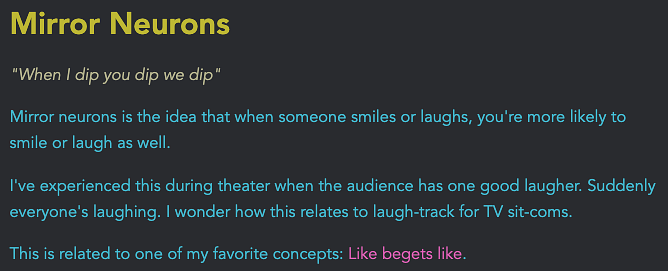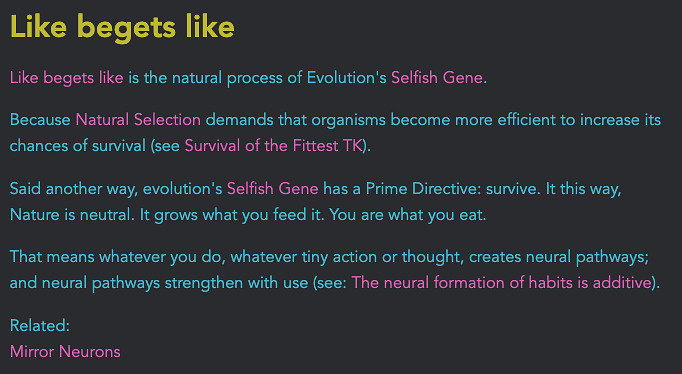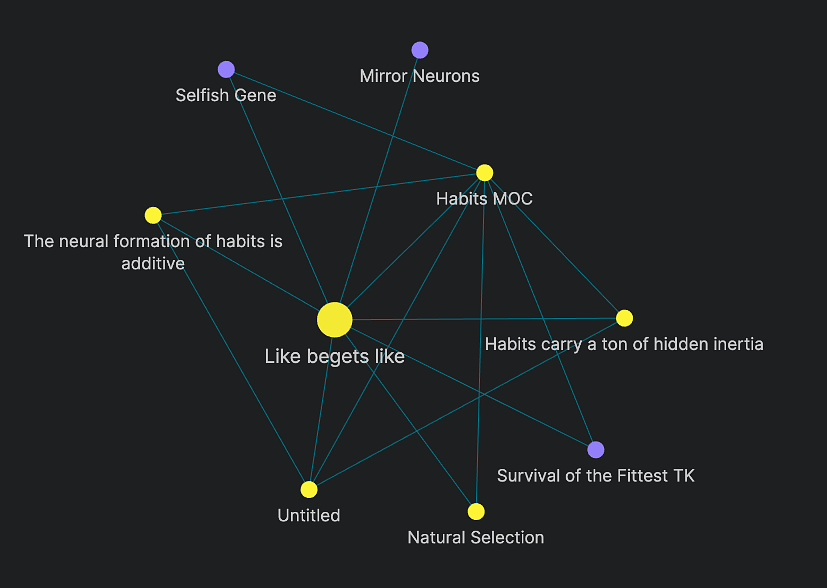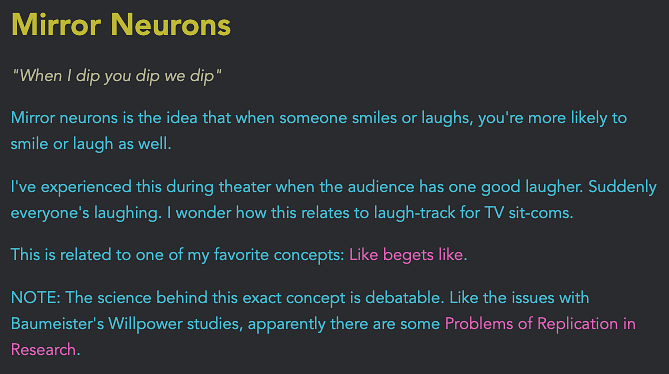2a5 - The compound effects of note-making
This second lesson will make the argument that spending time note-making (aka “Progressive Ideation”) creates great value, produces positive side effects, and is where you should be spending more (but not all) of your precious time. Let’s explore how to develop a growing PKM of Signal.
# The Compound Effects of Note-Making
- What if instead of spending time highlighting the highlights, you spent the same amount of time developing your own nuanced thoughts—your unique take—on the ideas you encounter?
- You create more joy and value when you spend time developing ideas—both in the moment and deep into the future.
- Instead of spending all our time in multi-step note-taking, if we are at all serious about having dependable and dynamic digital notes—notes that grow and evolve over time—we need to spend more time making notes. Formally, we might call this ==“Progressive Ideation”==, but in the day-to-day, I prefer just saying ==“note-making”.==
Progressive Ideation is the process of relating and developing ideas over time. Through this process, your thinking efforts naturally compound.
If practiced, “Progressive Ideation” will develop the habits of:
- engaged thinking (this leads to more “flow”)
- sensemaking (relating ideas and making leaps of insights)
- creative expression
# What does Progressive Ideation look like in practice?
It’s some version of the following:
- Create new ideas (or highlight (once!), comment on, or extract ideas)
- Connect ideas
- Develop ideas
- Create with those ideas (as needed)
This is a way to spend time in a high-value activity that ==encourages your own independent, connective thinking==—and grows with you deep into the future.
Very quickly in the process, you move from note-taking to note-making—==working with ideas in your own words.== You are not wasting time “highlighting the highlights”. You are more engaged with the material, but the engagement feels natural because ==you are having a conversation with the ideas you encounter.== It’s like you’re sitting down with the author of those ideas. You’re ready to chime in and say, “That reminds me of SUCH AND SUCH”. (Hmm…that’s a good prompt ;) )
- Now you can just continue to connect your new notes to existing notes — and develop both in a dialectic.
- You can’t help but ask powerful questions, “What does this relate to?”, “How does this relate?” And you start making wild connections. And guess what: you create VALUE from finding the fascinating intersections of ideas that transcend genre.
- From these “Thought Collisions” in your dynamically growing digital library, you naturally start to create stuff. An article. A product. A business. Or simply a well-connected, super dependable, digital conversation partner. One that knows all the same jokes you do! One that often says, “Hey, remember when…”
- Even if you don’t care to create THINGS, you can’t help but take your insights into each conversation you have with friends, family, and co-workers—enriching the experience for all.
And at every point along the way you are an active, engaged, and independent thinker.
Compare that to those multi-step highlighting techniques, which defer your best thinking for a mythical “someday later” so you can consume more content at a surface level. ==You end up spending more time copying other people’s thoughts rather than developing your own.==
The same amount of time spent collecting, reading, collecting, bolding, collecting, highlighting, and even more collecting endless streams of articles could instead be spent collecting less stuff, but developing more value from the stuff you do collect — like ==extracting insights, writing in your own words, and building deepening relationships in your digital note collection.==
You tell me which process sounds more engaging, more joyful—and ultimately, more valuable.
# Progressive Ideation creates real value
- When you read something important to you, ==what if you added comments as you went?== (Nothing major, just some comments like you were having an engaging conversation with a friend. For example, “Hmm, this relates to BLANK”.)
- What if you ==converted some of that information into a couple new notes==, each representing a core idea, each written in your own words?
- What if you then ==linked these new ideas to other existing ideas in your note library==?
Wouldn’t that be nice? What if you did this 1000 times? How valuable would your digital bank of ideas be then? Why, you would have an amazing, organic, dynamic digital library of your accumulated knowledge, intuitively connected through ideas.
A house would become a city. This is an imaginative example of how accumulated knowledge can grow into something profound.
Let’s compare the value you’re creating:
Multi-step highlighting techniques (chronic note-taking) is a ==low-value activity that encourages the bad habits of over-collecting, over-summarizing, and under-thinking. ==It’s a short-term means to an end.
Meanwhile, Progressive Ideation is a high-value activity. It’s inherently valuable, meaning it’s valuable for its own sake. But it’s not just inherently valuable. You are creating real value. Your thoughts have more value because you’ve related so many different, diverse things to each other. ==You are exercising the muscles that make you an independent thinker (and communicator).== You have more to offer in any conversation you enter. ==You are building a potent network of reusable ideas.==
You are no longer a regurgitation machine. You are a generation machine.
Progressive Ideation says:
Be active. Engage in a conversation with the author. Put ideas into your own words early in the process so you can start developing your take on them while you link them to other ideas. Do that and you will have great joy as your ideas naturally compound in value over time.
# Progressive ideation builds an evolving, dynamic digital library
Notes aren’t just static records of our thinking. Rather, we think with our notes.
≈ Richard Feynman
Once you start ==“thinking in ideas”== the world becomes a fascinating place. Every situation you encounter is ripe for spotting new ideas to add to your insanely dynamic digital library. Now get this: ==you might encounter the same texture of an idea in a completely different context. ==
I know that last sentence doesn’t seem like a game-changer, but I promise you, it is. ==You’ll be in a position to naturally make leaps of insights between unrelated concepts across domains.== A simple example is how concepts in Math rhyme with ideas in Music. Let’s explore an actual example below.
- Imagine coming across the the idea of “Mirror Neurons.” You think: “That’s a cool concept.”
- Basically, it’s the idea that when someone smiles or laughs, you’re more likely to smile or laugh as well. Or if you personified the idea, “When I dip you dip we dip”. So you make a new note called “Mirror Neurons”…
- Simultaneously, naturally, organically, you’re thinking: “What does this relate to?”… “Ah yes”, you say, then you connect it to a similar concept, “Like begets like”.
- And here’s the graph view of the connections in and out of “Like begets like”.
- But then you hear that Mirror Neurons are actually a debatable phenomenon currently. Here’s why Progressive Ideation is so valuable: ==You don’t delete the note, you just add the counter-example to the note.== You might branch off into a new note about the “Problems of Replication in Research”. And just like that, your note library has grown in value.
- I mean, how cool is that?! Not only does this system allow for excellent output of products, articles and other creations; it also just makes every moment more enjoyable for you and for others. Suddenly it’s easier to stay engaged in conversations. Suddenly, you’re making valuable leaps of insights in those same conversations. That’s more value.
These “evergreen” notes are the building blocks of original thought. And they are anti-fragile: ==they actually grow in value as they encounter new stressors!== See Antifragility)
Multi-step highlighting techniques (chronic note-taking) does not allow for anywhere near the same level of engaged, connective thinking that this simple example of Progressive Ideation creates. Now do this for a few years. The difference in compounded value is night and day.
# Progression Ideation compounds in value over time
Progressive Ideation gives you a massive advantage that only grows stronger as time goes on.
It focuses on ==merging ideas, concepts, and thoughts of other people into our own words and linking these new ideas into the web of knowledge we’ve already developed.== THIS is how our knowledge grows! This is how we learn and improve. This is how you should go about building your digital companion.
This solution isn’t completely new. It’s basically the ==zettelkasten method== which converts the author’s words into your words much earlier in the process and then assimilates whatever you extracted into your growing body of knowledge (via links).
In this way, ==you spend more time developing your thoughts (compounding value), as opposed to progressively curating other people’s thoughts.==
If chronic note-taking techniques add $1 to your personal GDP, Progressive Ideation adds $10 of value which then continues to compound over time. Your digital library grows in value as you naturally add more ideas, examples, and connections within it. So without much effort, you are dynamically evolving and building the complexity and relationships of your accumulated collection of ideas over time. Learn something new. Add it to the library. Connect it to existing knowledge.
Q: But what if the new stuff I add contradicts the old stuff?
A: Even better! You just link the new stuff with the old stuff and add your commentary. Now you have a high-level argument built into the note. This means: your digital library grows stronger from the randomness of life.
# We need you
Whether you are a “knowledge worker”, an entrepreneur, a manager, a creative professional, or just someone who likes to think… We need you.
We need you to be your best self. We need you to share your unique perspective and ideas with the rest of us.
I hope you can now clearly see how an over-reliance on multi-step highlighting techniques dangerously relegates your best thinking to the end of a process that you often won’t ever get to.
Whereas Progressive Ideation keeps you active and engaged throughout the process—encouraging better, more valuable contributions to the world that surrounds you.
A healthy world needs citizens who think, who question, who develop thoughts and ideas over time and build bridges across different domains.
Imaginative, connective—and at times, grounded—thinkers.
We need citizens capable of actively thinking for themselves—because through that process—==they will be able to provide a better experience to those within their orbit.==
We need you to spend the majority of your thinking time developing your thoughts and your nuanced perspective to the ideas you encounter.
Because ==a better you makes us all better.==



